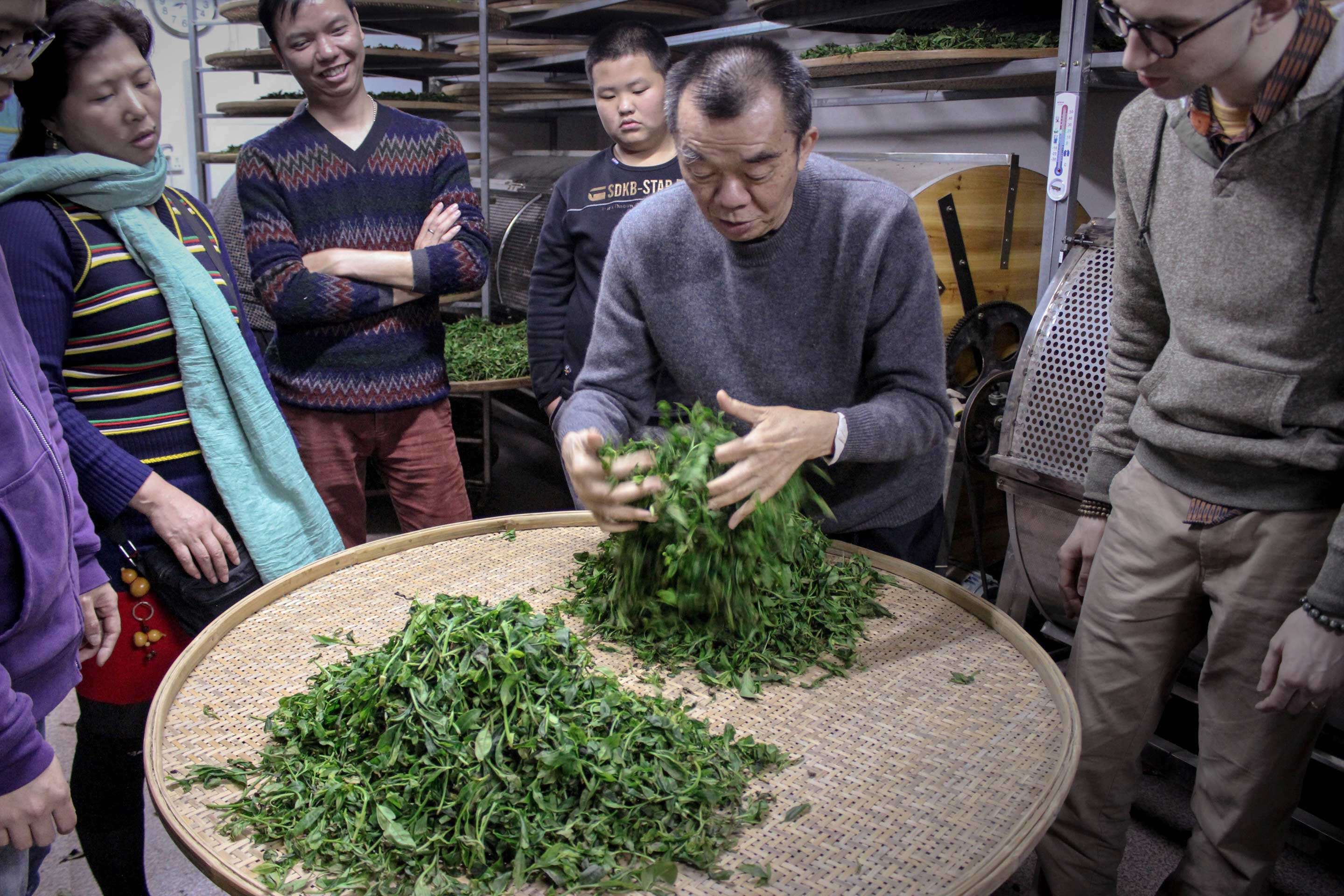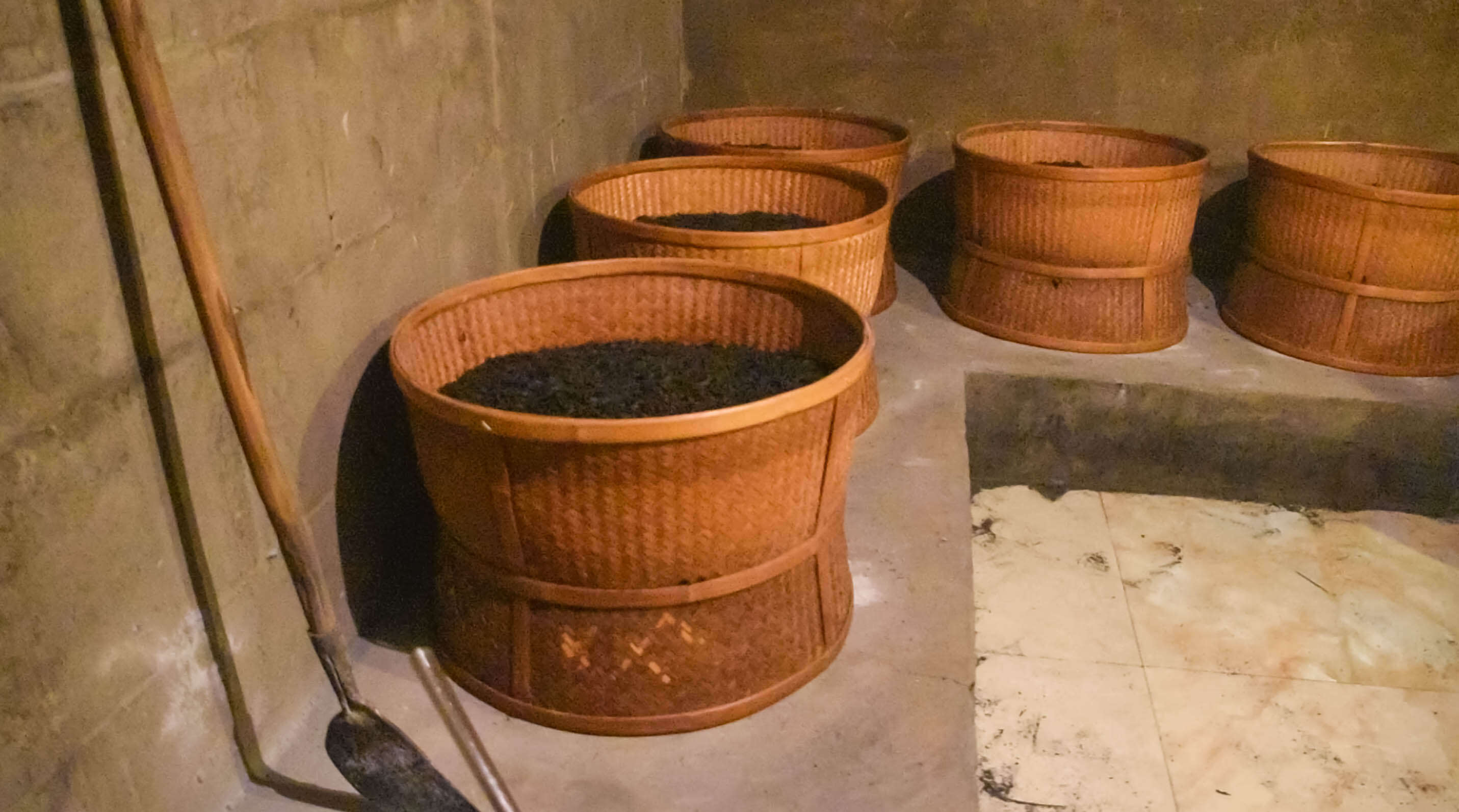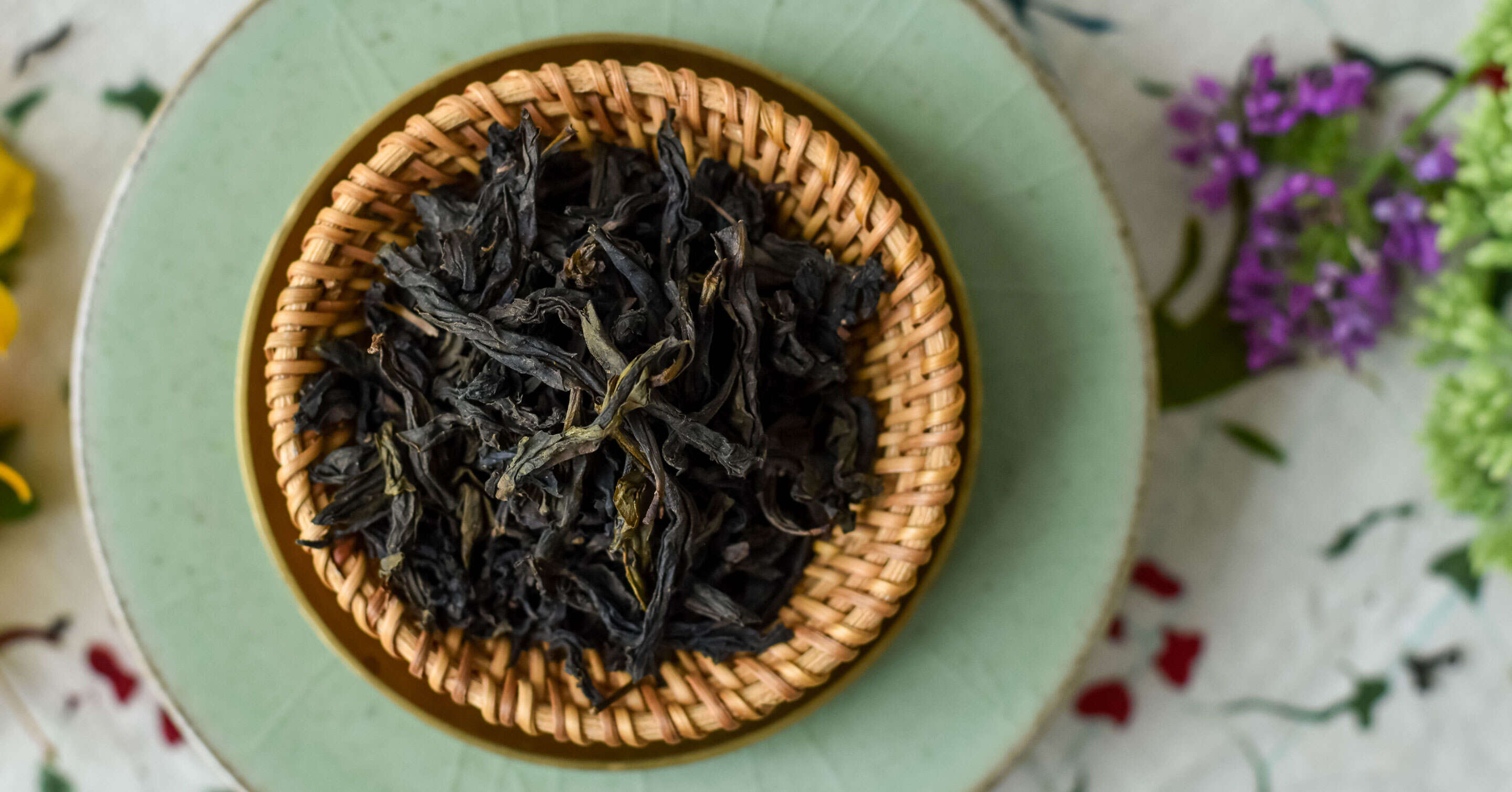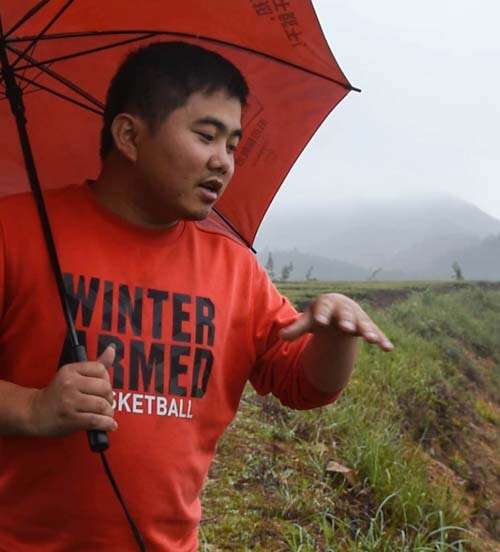Our partner, tea farmer and master craftsman Zhang Rongde sums up tea as 天地人 (tian di ren) or sky, earth and human. His meaning is that the quality of a tea is determined through the teamwork and collaboration of the plant in its natural environment, the climate, and the decisions and expertise of craft by the people finishing each leaf.

Yet within different types of tea, tian, di or ren can shine through more clearly.
Green tea, for example, requires great practices in the field and good terroir, but each picking is defined by the weather and the amount of sunlight the leaf was exposed to. It is a meditation on weather, or tian.
Wild-picked pu’er from Qianjiazhai is defined by place, finished with as little intervention as possible to let the natural flavor of the ancient tea trees and biodiverse surroundings shine through. These teas celebrate di or earth above all else.

The meticulous and subtle craft of oolong has to change each day to account for the weather and the leaves being picked, the humidity, and the seasons. It is the result of people looking at the incredible nuance and complexity of the tea plant and asking, “how can we bring out everything to its fullest through our choices in the workshop?”
above: Huang Ruiguang works with fresh Dancong leaves
What exactly in the process of craft defines oolong tea?
Oolong is not a kind of tea plant. It is not a varietal or style of picking. Oolong tea is a style of finishing.
Technically you could make oolong out of any tea picked anywhere in the world, though some teas are naturally better suited to become oolong because of their shape, their aromatics, and their textural nuance.
the craft that makes oolong “oolong” and different from any other tea craft is yao qing and tan qing, the alternating process of fluffing tea leaves and resting the leaves. Only oolong is subject to intentional fluffing to purposefully soften the leaves. This fluffing and resting is a delicate process that breaks down cell walls and allows for the oxidation of certain enzymes before heat fixing. Even more importantly, these alternating processes coax moisture out of the stems to distribute that moisture evenly through the leaves during shaping and eventual drying. This movement of enzymes and moisture through the leaf and the resulting interaction with the air is the true definition of oolong.
This unique process is not followed for any other type of tea.
Master oolong craftsman Zhang Rongde describes the alternating fluffing and resting as a dance between life and death for the leaves, with the changing aroma as the music that accompanies the dance. The craftsman directs the process by “listening” as the aroma changes, fluffing the leaves to coax out moisture and bring out deep aromatics, then resting the leaves to allow the moisture to evaporate and the aromatics to settle back into the leaves, time and time again, usually over about sixteen hours of straight labor.

Some masters like Huang Ruiguang in Fenghuang advocate for the oldest oolong processing style which is done entirely by hand by flipping bamboo baskets back and forth to agitate the leaves and then hand turning the leaf piles. This extremely hands-on approach yields intense aromatics, but can only be done by an accomplished master because a single wrong move could over-work and bruise the entire batch.
Other master oolong crafters like Mr. Li in Wuyishan or Zhang Rongde in Anxi prefer the results of a slow-turning bamboo cylinder that hot air is allowed to blow through. This combination of turning and hot air keeps the tea moving with minimal pressure on the leaf while the master technician periodically stops the cylinder for hand turning to fine-tune the aromas they are looking for and tailor the air exposure and moisture levels for each batch.
The result of these exhausting processes is a tea whose inherent aromatic complexity is preserved through heat-fixing instead of being lost or diminished. The work that goes into oolong is all about listening to the leaves and their aroma, adjusting the action of fluffing and resting to compensate for each batch and bringing that core aroma at the heart of the tea all the way through to the end.
Yet, our farmer-partners like Zhang Rongde in Anxi or Li Xiangxi in Wuyishan worry that mass market oolong has lost its way.
If the entire point of making oolong is to give the tea leaves the attention they need to preserve their inherent complexity, fully mechanizing that process and standardizing it across batches means that there is no one “listening” to the tea. Some batches will be over-processed and loose their aroma, while others will be under-processed and feel too simple or insubstantial. True hand-finishing in small batches is a huge commitment, but it is what gets our oolong partners up every morning, ready to meet the day.
For an oolong craftsperson, their work is the pillar of ren
that honors nature’s gift of di and tian by bringing out everything with care.
 Ming Wei demonstrates the techniques he learned from his father, Huang Ruiguang
Ming Wei demonstrates the techniques he learned from his father, Huang Ruiguang. Are there different ways to finish oolong?
With oolong at its heart being the balance of yaoqing and tanqing, the next question is: what happens after the technical master is satisfied with the aromatics and moisture level of the oolong processing?
There are different schools of thought across growing regions on the best way to finish each batch, and these differences create the main “styles” of oolong we see today. Some masters believe in minimal intervention post yaoqing in order to lock in the pure aroma and texture of the leaf, while others prefer to bring out those aromas further with different firing techniques or rolling techniques.
No matter what, masterfully-finished oolong will always amplify what is already there in the leaf.
. Dancong Oolong Finishing
The simplest, most “austere” finishing style within the oolong category is what is often practiced in Fenghuang to make fine Dancong.
Master Huang Ruiguang believes that an oolong is made or lost in yaoqing and that, post yaoqing, the goal should be to stabilize the tea by eliminating remaining moisture without introducing new variables. This is achieved by spreading tea in bamboo mesh trays and stacking them above a carefully-tended low heat wood fire in a clay oven and very slowly baking the tea after delicate twisting to preserve and protect the leaves in drying.
This baking process eliminates moisture remaining in the leaves without roasting them or giving them a dark deep flavor. The simplicity of the finishing technique mandates the intense hands-on yaoqing process for Dancong and gives fine Dancong its characteristic intensity of aroma and texture.


. Wuyi Oolong Finishing
True Wuyi Oolong is often imitated on the mass market but never matched.
This is because of the incredibly labor-intensive finishing process that dedicated award-winning farmers like the Li Family apply to their tea even after the sixteen hour yaoqing process.
Instead of baking their tea or drying it in drums, they eliminate the leaf’s remaining moisture through a painstaking hand-firing process. This hand-firing requires tiny batches of just a few kilos of leaf at a time to be turned in special bamboo baskets set over carefully-controlled Fujianese hardwood charcoal embers, allowing it to slowly and evenly roast, caramelizing sugars in the leaf and locking in deep potent aromatics.
This special finishing technique is used to bring out aroma through contrasting deep flavors and to bolster and magnify the yan yun, the textural after-sensations of fine Wuyi tea.

Lower quality mass market oolongs finished to look like Wuyi oolong are simply put through an oven on a conveyer belt several times to get a dark roast.
Hand-firing takes 3-5 rounds of 12 hour roasts over several months to finish, while oven-finishing can be done in minutes. The oven yields uneven roast and almost always covers up the original aromatics by giving too dark of a flavor. These mass-market oolongs are simple flavor-forward teas with no texture or true lingering aroma.
. Anxi Oolong Finishing
While Fenghuang and Wuyishan place the finishing emphasis on the choice of heat and the idea of either preserving austere pure aromatics or bolstering intensity through contrast, Anxi takes a different approach through post-yaoqing shaping.
The iconic ball-shaped finish of Anxi oolongs like Tieguanyin come from wrapping a kilo or two of leaves in a canvas bag and rolling the bag in stages during the drying process. This rolling process protects the leaves and allows them to dry more slowly than the strip-style oolongs of Wuyishan and Fenghuang.
The result is a more buttery creamy tea, where a rich texture develops. This creamy aesthetic is one of the trademark flavors of Anxi, and creates truly dessert-like oolongs when combined with the lilac and jasmine aroma that the yaoqing process brings out.
From fresh leaves to rolled oolong: the rolling process allows a rich texture to develop, creating a more buttery, creamy oolong tea.

Recently, Master Zhang Rongde has begun to research and experiment with older finishing styles.
These “new” teas don’t require a full rolling process, but instead demand extra rounds of yaoqing and both twisting and partial roll shaping to balance minerality, tingling yun sensations, creaminess and the natural florals of teas like Tieguanyin. This technique, called Revival Style is now being applied to Benshan and Tieguanyin varietal tea with incredible results.

. Other Innovations
While the trademark defining characteristic of oolong is the yaoqing process, there has been boundless innovation in the post-yaoqing finishing among this generation of tea farmers.
Beyond Master Zhang’s work reviving old techniques, the He Family in Laoshan have been experimenting with new oolongs using a varietal of leaf normally associated with Dragonwell green tea. They are experimenting with heat fixing at the very end of the process instead of before yaoqing so that their oolong can oxidize like black tea while still getting finished like oolong.
It is exciting to see new styles like this developing all over China.


What tea makes good oolong?
So far, we’ve gone over lots of in depth techniques for finishing that make oolong teas so special, but what about the tea leaves themselves? As Master Zhang advocates, tea is a collaboration between nature, the plant itself, and the people finishing it.

One of the most important factors is leaf size and shape.
Because of the intense amount of finishing that the leaves must go through, oolong tea leaves tend to yield the most complexity and depth if they are naturally larger and thicker leaves.
The thickness means more retained moisture to work out through yaoqing and more complexity through slower finishing. The large shape allows for more twisting, curling and rolling, as well as larger veining in the leaves to coax moisture out of.
Tiny buds may look beautiful in high end black teas, but they would never survive the processing required for oolong tea, and would be far too difficult to use.
Cultivar is another important choice.
Beyond the shape and size of the leaf, it helps to pick out varietals with naturally potent aromatics that can be brought out further through yaoqing finishing.
Examples of deep, aroma-driven varietals include Tieguanyin, Mi Lan, Qi Lan, or Shui Jin Gui.

Finally, and critically, the environment where a tea grows plays a huge role in determining its potential to become great.
The finest oolongs grow in biodiverse landscapes that have preserved natural forest cover for a balanced ecosystem that self-regulates without the need for pesticides, or even irrigation. Plants in a balanced ecosystem put out more flavor and aroma as their natural defense against insects and other competition.
High mountain plots are often best because they are cool enough that the plant can store up more sugars more slowly and because they are more likely to have rocky fast-draining soil instead of the clay more common at low elevation. Rocky soil encourages deeper roots and yields more texture in the finished tea.
Not sure where to start?
As always, the best way to ensure that you are getting high quality tea is to buy from small family farms. A family farm model gives owners the incentive to maintain a balanced sustainable ecosystem that they can pass on to their children and grandchildren, and a small family farm allows farmers to commit to quality before profit to build long-term recognition instead of satisfying investors.
We are lucky enough to work with five oolong-producing small family farmers in China. If you are interested in learning about each family and the regions they call home, you can learn more below:
Li Xiangxi, Wuyishan
The most famous and most sought after oolong in China comes from the Wuyi Ecological Preserve, and the Li Family leads the way in craft and sustainability in the region.
Learn more, or try the Li Family’s Wuyi Tea Sampler
Zhang Rongde, Anxi
Master Zhang is a pioneer in bringing zero-impact tea farming to Anxi, reforesting the mountainsides and re-developing ancient techniques. He cultivates true Tieguanyin and dozens of other rare varietals on high high mountain plot.
Read more or try Master Zhang’s Anxi Oolong Sampler
Huang Ruiguang, Fenghuang
Huang Ruiguang has been declared a living cultural treasure by the local government and is famous for his work shaping Dancong tea into the famous sought after tea that it is today.
Learn more or try Huang Ruiguang’s Dancong oolong sampler.
Liu Family, Longjuan
The Liu Family grow Tieguanyin varietal at a high elevation plot in the lesser known Longjuan region, and have begun to explore black tea finishing as well as pressing cakes of oolong for aging.
Learn more, or shop the Liu collection
He Family, Laoshan
The He Family were some of the first to plant tea in Laoshan Village, and pioneered the green tea that made the region famous. Now they are beginning to experiment with incredibly unique oolongs using delicate tender leaves from their oceanside plot.
Learn more, or try the He Family sampler


 How To
How To Myths & Legends
Myths & Legends Travelogue
Travelogue Tasting Journal
Tasting Journal Talking Shop
Talking Shop Tea 101
Tea 101 Watch
Watch Teaware
Teaware News
News















Leave a Reply
Love the simplicity of tian di ren! I too have a simple concept I use to be ren in collaboration with the tea while drinking it. My heart revealed the simplicity of Eternal Grace in all things, and the unity of that kingdom through color, animal, plant, and mineral. When drinking tea I get present with my own Eternal Grace Presence in collaboration with the Eternal Grace Presence of the tea. An experience of reverence drinking in its unity kingdom wisdom of terroir, growing environment, aroma, color, varietal, and ren master crafted finishing. An aliveness in each sip embodied in the Eternal Grace Presence of the teas journey as Creator knows it to be~.
Thank you David for such an educational and storytelling joyousness about tea.
Question- Your Oolong tea has helped me with a life long digestive problem. My gastrointestinal doctor wants to know the ingredients in the tea. I told him I believe it’s just tea. Is there anything that is added to the tea? Thank you!
The only ingredient is tea, Ms. Ortiz! :) None of our partners' oolong teas are blended with other ingredients, with the exception of the He Family's Laoshan Osmanthus Oolong (blended with local Laoshan osmanthus blossoms). Best wishes - Lily
i have a question. Somewhere I read that one way you can tell the quality of a high mountain green oolong tea is that the edges of the tea will be a bit jagged because the process of shaking and heating will oxidize the edges, making them very slightly brown and then shaking this off. So, they say, when these oxidized edges are shaken off, it shows that the leaves have been processed the required amount of time--and that if the leave appears whole with no ragged edges, it hasn't been processed thoroughly. Is this true, or only of some high mountain oolongs?